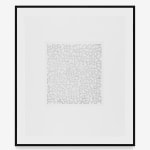-
Anni Albers
Triangulated Intaglio I, 1976Single-color copper plate etching on mould-made white Arches Cover24 x 20 in (61 x 50.8 cm)Edition of 20, plus 9 AP© 2025 The Josef and Anni Albers Foundation / Artists Rights Society (ARS), New York. Courtesy of Zeit Contemporary Art, New YorkA luminary of modernist abstraction and a pioneer in textile art, Anni Albers brought her signature exploration of geometry and pattern into the realm of printmaking. With ‘Triangulated Intaglio I’...A luminary of modernist abstraction and a pioneer in textile art, Anni Albers brought her signature exploration of geometry and pattern into the realm of printmaking. With ‘Triangulated Intaglio I’ from 1976, she demonstrates her mastery of precision and abstraction, utilizing a single-color copper plate etching to achieve an intricate, poetic composition. This work, subtle in its tonal nuances yet no less sophisticated than its counterpart ‘Triangulated Intaglio II,’ reveals Albers’s unique capacity to evoke depth and rhythm with the simplest of elements: a constellation of meticulously etched dots.
The single-color intaglio technique used here underscores Albers's profound understanding of materiality and craftsmanship. Forgoing the broader tonal contrasts achieved through aquatint, Albers relies solely on the density and arrangement of her etched marks. Each dot vibrates with intentionality, coalescing into a labyrinth of triangular forms that gently oscillate between presence and absence. This rhythmic subtlety imbues the composition with a meditative silence, inviting the viewer to engage in a contemplative visual dialogue. It is in this quiet restraint that Albers’s voice as an artist becomes most resonant.
Unlike the bold interplay of black and white in ‘Triangulated Intaglio II,’ the delicacy of the present work evokes the soft tactility of woven fabric. The network of triangles, rendered through dots, seems to shimmer, as if the surface itself were breathing. This quality of imperceptible motion—a hallmark of Albers’s work—bridges the tactile sensibility of her textile practice with the optical precision of printmaking, creating a fluid exchange between mediums.
Albers’s embrace of the intaglio technique reflects her deep respect for historical processes while simultaneously reimagining their possibilities within a modernist framework. At a time when such techniques were considered traditional, her innovative approach reaffirms her role as a forward-thinking artist committed to exploring the boundaries of form and material. In ‘Triangulated Intaglio I,’ Albers elevates the act of mark-making into a sublime orchestration of structure and harmony, reminding us that even in the most minute details lies the potential for infinite complexity.
This print exemplifies Albers’s lifelong dedication to the union of art and craft. The elegant intricacy of its composition, achieved through an economy of means, speaks to her belief in the power of simplicity. In the present work, Albers etches not only her mastery into the copper plate but also her enduring influence into the broader tapestry of modern art history—a quiet yet commanding voice that continues to inspire.
Other examples of this edition are housed in the esteemed collections of the Walker Art Center, Minneapolis, MN, The Brooklyn Museum, NY, Hood Museum of Art, Hanover, New Hampshire, and The Josef and Anni Albers Foundation, Bethany, CT, among others.
NOTES:
Image: 12 7/8 x 11 3/4 in (32.7 x 29.8 cm)
Sheet: 24 x 20 in (61 x 50.8 cm)
This artwork is signed, dated and numbered in pencil, from the edition of 20, plus 9 artist's proofs.Provenance
Private collection, Europe
Private collection, New York
Exhibitions
Syracuse, NY, Syracuse University Art Museum, Anni Albers: Work with Materials, August 25 – December 11, 2022 (another example exhibited).Literature
Brenda Danilowitz and Nicholas Fox Weber. The Prints of Anni Albers: A Catalogue Raisonne, 1963-1984. Bethany, CT: The Josef and Anni Albers Foundation, 2009, no. 42, p. 104 (another example illustrated, p. 106).




